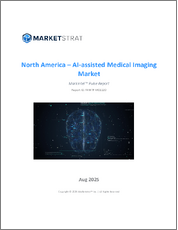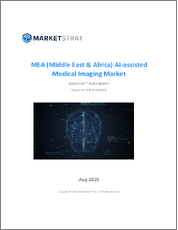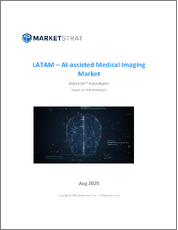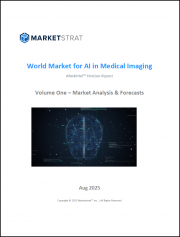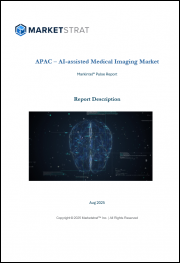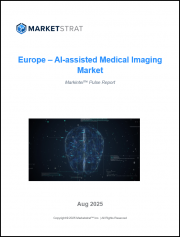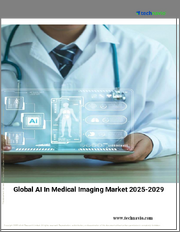
|
시장보고서
상품코드
1371875
세계 의료 영상 진단 분야 AI 시장 : 전개 모드, 솔루션, 기술, 영상 진단 모드, 용도, 최종사용자 및 지역별(-2030년)Artificial Intelligence in Medical Imaging Market Forecasts to 2030 - Global Analysis By Deployment Mode, Solution, Technology (Deep Learning, Natural Language Processing and Other Technologies), Imaging Mode, Application, End User and By Geography |
||||||
Stratistics MRC에 따르면 세계 의료 영상 진단 분야 인공지능(AI) 시장은 2023년 17억 7,000만 달러를 차지하고 예측 기간 동안 복합 연간 성장률(CAGR) 28.5%를 나타낼 전망이며 2030년에는 102억 5,000만 달러에 달할 것으로 예상됩니다.
의료 영상 진단에 있어서의 인공지능(AI)이란, 초음파, 컴퓨터 단층 촬영(CT), 자기 공명 영상(MRI), X선 등, 다양한 영상 modalities에 AI 기술을 적용해, 의료 영상의 처리를 개선 및 자동화하는 것을 의미합니다. 고도의 알고리즘과 머신러닝 모델을 이용하여 의료 영상에서 중요한 정보를 분석·추출해 다양한 질병이나 질환의 인식, 진단, 치료에 도움을 줍니다.
미국 암 협회에 따르면 미국에서는 올해 폐암과 기관지암의 합계 236,740명이 새로 이환할 것으로 추정되고 있습니다.
AI를 활용한 의료용 영상 진단 신흥기업 증가
현재 의료 영상 진단 시장은 AI가 견인하고 있습니다. 이 소프트웨어는 의사가 질병을 더 신속하게 진단하고 조기 개입을 허용하는 이점을 제공하기 때문입니다. 또한 새로운 AI 주도 신흥 기업은 AI 의료 이미지 솔루션에 중점을 두고 정교한 기능을 추가하고 있습니다. 의료 영상 진단에서 AI를 발전시키기 위해서는 이 분야에 대한 자금 제공과 투자를 늘릴 필요가 있습니다. 예를 들어, 리투아니아의 oxipit.ai는 2023년 1월에 490만 달러의 자금을 조달하여 완전 자율 AI 의료 영상 진단를 개발하고 새로운 지역에서 시장을 확대했습니다. 이와 같이 세계 AI 주도 신흥기업 수 증가와 완전 자율형 AI 의료 영상 진단 툴의 개발에 대한 자금 조달 증가에 의해 시장의 성장이 촉진되고 있습니다.
의료 영상 진단에서 AI 비용 증가
의료 영상 진단 시장의 성장은 많은 질병을 진단하기 위해 의료 영상 샘플 및 기타 장비에 사용되는 다양한 인공지능 기술의 비용이 높다는 제한이 있습니다. 현재 저개발국이나 개발도상국의 병원이나 연구기관의 대부분은 의료용 영상 진단에 있어서의 인공지능의 조사연구와 관련된 높은 비용을 지불할 여유가 없습니다. 이러한 이유로 이러한 요인은 시장 성장을 방해합니다.
건강 관리에서 AI 기반 컴퓨터 비전 모델 구현
향후 몇 년간 첨단 AI 도구와 기술이 의료 및 방사선 업계를 크게 바꿀 것으로 예상됩니다. 현재의 의료 영상 진단 산업에서 AI에 종사하는 기업들은 의료 분야, 특히 방사선과에서 AI의 도입이 폭넓은 기회를 가져올 것으로 예상하고 있습니다. 게다가, 증가하는 스캔 수와 데이터를 읽을 수 있는 방사선과 의사의 수 사이의 격차의 확대는 의료 영상 진단 시장에서 AI의 채택을 조장하는 주요 요인입니다.
보안 우려와 엄격한 규정
데이터 유출 및 환자 데이터에 대한 무단 액세스는 의료용 영상 진단에서 AI의 보급을 방해할 수 있습니다. 시장 진출기업의 경우 데이터 접근성과 프라이버시 간의 균형을 잡는 것은 어렵습니다. 또한 AI를 의료 영상 진단에 사용하려면 규칙과 법적 요구 사항을 준수해야 합니다. 의료용 AI 알고리즘의 개발과 응용에는 관리 단체나 의료기기 당국이 정하는 엄격한 규제를 따라야 합니다. 이러한 측면은 시장 확대를 제한합니다.
COVID-19의 영향:
COVID-19의 대유행은 건강 관리를 제외한 세계 거의 모든 산업에 큰 영향을 미쳤습니다. 건강 관리 분야에서 AI 대응 솔루션이 개발되고 있는 주요 분야는 의료용 영상 진단입니다. COVID-19는 감염과 폐 질환의 영상 진단에 널리 사용되고 있기 때문에 방사선과에서는 많은 병원에서 이용이 크게 증가하고 있습니다. 유행과 기술 및 디지털 솔루션에 대한 수요 증가에는 강한 상관 관계가 있습니다. COVID-19 기술의 영향은 중장기적으로 매우 긍정적일 수 있습니다.
예측 기간 동안 X선 부문이 최대가 될 것으로 예상
예측 기간 동안 X선 부문이 최대 시장 점유율을 차지할 것으로 예측됩니다. X선 modalities의 AI 수요는 정확도가 높아지고 있습니다. X선 영상과 AR 및 VR 기술의 통합으로 방사선 기사는 몰입형 인터랙티브한 경험을 할 수 있게 되었습니다. 의료 종사자는 X선 이미지를 3차원으로 볼 수 있으며 해부학적 세부 사항을 중첩하거나 수술 전 계획을 위한 절차를 시뮬레이션할 수 있습니다. 또한, 이러한 도구는 보다 정확한 해석을 용이하게 하고, 공간 이해력을 향상시키고, 부문의 진행을 가속화합니다.
예측 기간 동안 복합 연간 성장률(CAGR)이 가장 높을 것으로 예상되는 유방 스크리닝 분야
예측 기간 동안 유방 스크리닝 분야는 가장 높은 성장률로 확대될 것으로 예측됩니다. 유방 스크리닝 수요는 유방암 환자 증가와 가능한 한 빨리 적절한 치료를 받는 데 도움이되는 조기 진단에 대한 환자의 요구에 의해 견인되고 있습니다. 또한, 임상적 해석을 지원하는 정부의 initiative와 유방암 검진 기술에 대한 접근 확대가 부문 확대를 촉진할 것으로 예상되는 두 가지 주요 요인입니다.
최대 점유율을 차지하는 지역:
기술적으로 정교한 인프라와 높은 1인당 소득으로 북미는 2022년 시장을 독점하였고 예측 기간 동안도 지배적이라고 예측되고 있습니다. 의료 영상 진단에 있어서의 AI 시장은 수많은 시장 기업의 존재와 이 지역의 유리한 정부 규정에 의해 견인되고 있습니다. 또한 이 지역의 연구기관과 건강 관리 기관은 AI에 상당한 투자를 하고 있습니다. 또한 주요 업계 선수들의 강한 존재감과 활발한 건강 관리 인프라가 이 지역의 성장을 가속하고 있습니다.
복합 연간 성장률(CAGR)이 가장 높은 지역:
최첨단 기술의 보급, 네트워크 연결 개선, 정부 활동 확대로 아시아태평양이 가장 높은 성장률을 보일 것으로 예상됩니다. 투자의 급격한 증가, 특히 중국과 인도에서 인공지능(AI)을 사용하는 신흥기업 증가, 화질을 향상시킴으로써 이 지역의 의료 인프라 격차를 해소하는 AI의 큰 가능성은 더욱 원동력이 되고 있습니다. 이러한 기술은 임상 가치가 높고 시장 성장을 가속합니다.
무료 맞춤 설정 서비스:
이 보고서를 구독하는 고객은 다음 무료 맞춤설정 옵션 중 하나를 사용할 수 있습니다.
- 기업 프로파일
- 추가 시장 기업의 종합적 프로파일링(3사까지)
- 주요 기업의 SWOT 분석(3사까지)
- 지역 세분화
- 고객의 관심에 응한 주요국 시장 추계,예측 및 복합 연간 성장률(CAGR)(주: 타당성 확인에 따름)
- 경쟁 벤치마킹
- 제품 포트폴리오, 지리적 존재, 전략적 제휴에 기반한 주요 기업 벤치마킹
목차
제1장 주요 요약
제2장 서문
- 개요
- 이해관계자
- 조사 범위
- 조사 방법
- 데이터 마이닝
- 데이터 분석
- 데이터 검증
- 조사 접근
- 조사 소스
- 1차 조사 소스
- 2차 조사 소스
- 전제조건
제3장 시장 동향 분석
- 소개
- 성장 촉진요인
- 억제요인
- 기회
- 위협
- 기술 분석
- 용도 분석
- 최종 사용자 분석
- COVID-19의 영향
제4장 Porter's Five Forces 분석
- 공급기업의 협상력
- 구매자의 협상력
- 대체품의 위협
- 신규 참가업체의 위협
- 경쟁 기업간 경쟁 관계
제5장 세계 의료 영상 진단 분야 AI 시장 : 전개 모드별
- 소개
- 온프레미스
- 클라우드 기반
제6장 세계 의료 영상 진단 분야 AI 시장 : 솔루션별
- 소개
- 소프트웨어 툴 및 플랫폼
- 서비스
- 통합
- 도입
제7장 세계 의료 영상 진단 분야 AI 시장 : 테크놀로지별
- 딥러닝
- 자연어 처리(NLP)
- 기타 기술
제8장 세계 의료 영상 진단 분야 AI 시장 : 영상 모드별
- 소개
- 컴퓨터 단층 촬영(CT) 스캔
- 자기 공명 영상법(MRI)
- 분자 이미징
- 의료 영상 진단의 AI시장
- 초음파 영상 진단
- X선
- 기타 촬상 모드
제9장 세계 의료 영상 진단 분야 AI 시장 : 용도별
- 소개
- 신경 내과
- 호흡기와 폐
- 심장병학
- 유방암 검진
- 병리학
- 구강 진단
- 정형 외과
- 기타 용도
제10장 세계 의료 영상 진단 분야 AI 시장 : 최종 사용자별
- 소개
- 클리닉
- 영상 진단센터
- 병원
- 조사
- 기타 최종 사용자
제11장 세계 의료 영상 진단 분야 AI 시장 :지역별
- 북미
- 미국
- 캐나다
- 멕시코
- 유럽
- 독일
- 영국
- 이탈리아
- 프랑스
- 스페인
- 기타 유럽
- 아시아태평양
- 일본
- 중국
- 인도
- 호주
- 뉴질랜드
- 한국
- 기타 아시아태평양
- 남미
- 아르헨티나
- 브라질
- 칠레
- 기타 남미
- 중동 및 아프리카
- 사우디아라비아
- 아랍에미리트(UAE)
- 카타르
- 남아프리카
- 기타 중동 및 아프리카
제12장 주요 발전
- 계약, 파트너십, 협업 및 합작투자(JV)
- 인수와 합병
- 신제품 발매
- 사업 확대
- 기타 주요 전략
제13장 기업 프로파일
- 1QB Information Technology
- Agfa-Gevaert Group
- Arterys Inc
- AZmed
- BenevolentAI
- BioXcel Therapeutics Inc
- Butterfly Network
- Caption Health
- CellmatiQ
- dentalXrai
- Digital Diagnostics
- EchoNous
- Enlitic, Inc
- GE Healthcare
- Gleamer
- HeartVista
- IBM Watson Health
- K Health
- Koninklijke Philips
- mPulse Mobile
- Nanox Imaging
- OrCam
- Owkin Inc.
- Siemens Healthineers AG
- Suki AI, Inc
- Ultromics
- Viz.ai, Inc
- ZealthLife technologies Pte. Ltd
- Zebra Medical Vision
According to Stratistics MRC, the Global Artificial Intelligence (AI) in Medical Imaging Market is accounted for $1.77 billion in 2023 and is expected to reach $10.25 billion by 2030 growing at a CAGR of 28.5% during the forecast period. Artificial intelligence (AI) in medical imaging refers to the application of AI techniques to a variety of imaging modalities, including ultrasound, computed tomography (CT), magnetic resonance imaging (MRI), and X-rays, to improve and automate the processing of medical images. It involves analyzing and extracting significant information from medical images using sophisticated algorithms and machine learning models in order to aid in the recognition, diagnosis, and treatment of a variety of illnesses and ailments.
According to the American Cancer Society, a total of 236,740 new cases of lung and bronchus cancer are estimated this year in the United States.
Market Dynamics:
Driver:
Increase in AI-Powered medical imaging start-ups
The market for medical imaging is being driven by AI in the current scenario. This is because the software gives doctors a benefit by making it possible for them to diagnose illnesses much more quickly and enable earlier intervention. Additionally, new AI-driven start-ups are putting an emphasis on and adding sophisticated features to AI medical imaging solutions. To advance AI in medical imaging, it is also necessary to increase funding and investment in the field. For instance, Lithuania's oxipit.ai raised USD 4.9 million in funding in January 2023 to develop fully autonomous AI medical imaging and broaden the market in new regions. Thus, market growth is being driven by the rising number of AI-driven start-ups globally and the rising funding for the development of fully autonomous AI medical imaging tools.
Restraint:
Increasing cost of AI in medical imaging
The market's growth is constrained by the high cost of various artificial intelligence techniques used in medical imaging samples and other equipment for diagnosing many diseases. The majority of hospitals and research institutions in underdeveloped and developing nations are currently unable to afford the higher costs associated with the R&D of artificial intelligence in medical imaging. These factors thus inhibit market growth.
Opportunity:
Implementation of AI-based computer vision models in healthcare
In the upcoming years, it is anticipated that advanced AI tools and technology will significantly change the healthcare and radiology industries. Companies involved in the current AI in the medical imaging industry anticipate that the adoption of AI in the medical field, particularly in radiology, will present a wide range of opportunities. Moreover, the growing disparity between the rising number of scans and the number of available radiologists who can read data is a major factor that will aid in the adoption of AI in the medical imaging market.
Threat:
Security concerns and stringent regulations
Data breaches or unauthorized access to patient data could hinder the widespread use of AI in the medical imaging industry. Finding a balance between data accessibility and privacy will be difficult for market participants. Additionally, AI must adhere to rules and legal requirements before it can be used in medical imaging. Strict regulations, such as those set forth by governing bodies and medical device authorities, must be followed in the development and application of AI algorithms for medical applications. Such aspects limit the market from expanding.
COVID-19 Impact:
The COVID-19 pandemic has had a significant impact on nearly every industry worldwide, with the exception of healthcare. The primary area in the healthcare sector where AI-enabled solutions are being developed is medical imaging. Due to the widespread use of COVID-19 for imaging infectious and lung diseases, radiology has seen a significant increase in use in many hospitals. A strong correlation exists between the pandemic and the increased demand for technology and digital solutions. The impact of COVID-19 technology could be very positive in the medium to long term.
The X-rays segment is expected to be the largest during the forecast period
During the forecast period, the X-ray segment is anticipated to hold the largest market share. The demand for AI in X-ray modalities has increased due to its high accuracy. Radiologists can now experience immersive and interactive experiences thanks to the integration of AR and VR technologies with X-ray imaging. X-ray images can now be seen in three dimensions by medical professionals, who can also overlay anatomical details or simulate procedures for preoperative planning. Moreover, these tools can facilitate more accurate interpretations and improve spatial comprehension, which would accelerate segment progression.
The breast screening segment is expected to have the highest CAGR during the forecast period
It is anticipated that during the forecast period, the breast screening segment will expand at the highest rate. The demand for breast screening is being driven by the increase in breast cancer cases and patients' desires for an early-stage diagnosis, which aids in receiving the proper treatment as soon as possible. Furthermore, government initiatives that support clinical interpretation and expanded access to breast cancer screening technologies are two additional major factors that are anticipated to fuel segment expansion.
Region with largest share:
Due to the technologically sophisticated infrastructure and high per capita income, North America dominated the market in 2022 and is predicted to dominate over the forecast period. The market for AI in medical imaging is being driven by the presence of numerous market players and favorable government regulations in the area. In addition, the region's research organizations and healthcare institutions are making significant investments in AI. Furthermore, a strong presence of major industry players and a thriving healthcare infrastructure are fostering regional growth in this region.
Region with highest CAGR:
Due to the widespread adoption of cutting-edge technologies, improved network connectivity, and expanded government initiatives, Asia Pacific is anticipated to experience the highest growth rate. The exponential growth in investment, the rise in artificial intelligence (AI)-using startups, particularly in China and India, and the enormous potential for AI to close the region's healthcare infrastructure gap by enhancing image quality are additional motivating factors. These technologies also have a high clinical value, which is promoting market growth.
Key players in the market:
Some of the key players in Artificial Intelligence (AI) in Medical Imaging market include: 1QB Information Technology, Agfa-Gevaert Group, Arterys Inc, AZmed, BenevolentAI, BioXcel, Therapeutics Inc, Butterfly Network, Caption Health, CellmatiQ, dentalXrai, Digital Diagnostics, EchoNous, Enlitic, Inc, GE Healthcare, Gleamer, HeartVista, IBM Watson Health, K Health, Koninklijke Philips, mPulse Mobile, Nanox Imaging, OrCam, Owkin Inc., Siemens Healthineers AG, Suki AI, Inc, Ultromics, Viz.ai, Inc, ZealthLife technologies Pte. Ltd and Zebra Medical Vision.
Key Developments:
In October 2023, BioXcel Therapeutics, Inc., a biopharmaceutical company utilizing artificial intelligence approaches to develop transformative medicines in neuroscience, today provided an update on recent developments with its late-stage clinical programs as well as its patent portfolio for IGALMI™ (dexmedetomidine) sublingual film. These developments include meetings scheduled with the U.S. Food and Drug Administration (FDA) to discuss the TRANQUILITY and SERENITY III clinical programs and the receipt of two Notices of Allowance (NOAs) from the U.S. Patent and Trademark Office to extend method of use patent protection for sublingual dexmedetomidine.
In August 2023, Butterfly Network, Inc. a digital health company transforming care through the power of portable, semiconductor-based ultrasound technology and intuitive software, announced the release of its software development kit (SDK) for use by third parties. The kit will allow developers to utilize Butterfly's platform to build custom applications that can be commercialized to Butterfly's customer base - the largest user network in handheld point-of-care ultrasound.1 The Company ultimately plans to open "Butterfly Garden," an AI Marketplace where new apps will be hosted for Butterfly users to discover and purchase the latest AI capabilities.
In April 2023, AGFA HealthCare, a leading provider of Enterprise Imaging solutions, is proud to announce that it has joined the Amazon Web Services (AWS) Partner Network (APN) to scale up the global availability of AGFA Enterprise Imaging (AGFA EI) VNA and XERO® Universal Viewer on the cloud. The APN is a global community of AWS Partners that leverage programs, expertise, and resources to build, market, and sell customer offerings.
Deployment Modes Covered:
- On-Premise
- Cloud Based
Solutions Covered:
- Software Tools/ Platform
- Services
Technologies Covered:
- Deep Learning
- Natural Language Processing (NLP)
- Other Technologies
Imaging Modes Covered:
- Computed tomography (CT) Scan
- Magnetic Resonance Imaging (MRI)
- Molecular Imaging
- Nuclear Imaging
- Ultrasound Imaging
- X-rays
- Other Imaging Modes
Applications Covered:
- Neurology
- Respiratory and Pulmonary
- Cardiology
- Breast Screening
- Pathology
- Oral Diagnostics
- Orthopedics
- Other Applications
End Users Covered:
- Clinics
- Diagnostic Imaging Centers
- Hospitals
- Introduction
- Research Laboratories
- Other End Users
Regions Covered:
- North America
- US
- Canada
- Mexico
- Europe
- Germany
- UK
- Italy
- France
- Spain
- Rest of Europe
- Asia Pacific
- Japan
- China
- India
- Australia
- New Zealand
- South Korea
- Rest of Asia Pacific
- South America
- Argentina
- Brazil
- Chile
- Rest of South America
- Middle East & Africa
- Saudi Arabia
- UAE
- Qatar
- South Africa
- Rest of Middle East & Africa
What our report offers:
- Market share assessments for the regional and country-level segments
- Strategic recommendations for the new entrants
- Covers Market data for the years 2021, 2022, 2023, 2026, and 2030
- Market Trends (Drivers, Constraints, Opportunities, Threats, Challenges, Investment Opportunities, and recommendations)
- Strategic recommendations in key business segments based on the market estimations
- Competitive landscaping mapping the key common trends
- Company profiling with detailed strategies, financials, and recent developments
- Supply chain trends mapping the latest technological advancements
Free Customization Offerings:
All the customers of this report will be entitled to receive one of the following free customization options:
- Company Profiling
- Comprehensive profiling of additional market players (up to 3)
- SWOT Analysis of key players (up to 3)
- Regional Segmentation
- Market estimations, Forecasts and CAGR of any prominent country as per the client's interest (Note: Depends on feasibility check)
- Competitive Benchmarking
- Benchmarking of key players based on product portfolio, geographical presence, and strategic alliances
Table of Contents
1 Executive Summary
2 Preface
- 2.1 Abstract
- 2.2 Stake Holders
- 2.3 Research Scope
- 2.4 Research Methodology
- 2.4.1 Data Mining
- 2.4.2 Data Analysis
- 2.4.3 Data Validation
- 2.4.4 Research Approach
- 2.5 Research Sources
- 2.5.1 Primary Research Sources
- 2.5.2 Secondary Research Sources
- 2.5.3 Assumptions
3 Market Trend Analysis
- 3.1 Introduction
- 3.2 Drivers
- 3.3 Restraints
- 3.4 Opportunities
- 3.5 Threats
- 3.6 Technology Analysis
- 3.7 Application Analysis
- 3.8 End User Analysis
- 3.9 Impact of Covid-19
4 Porters Five Force Analysis
- 4.1 Bargaining power of suppliers
- 4.2 Bargaining power of buyers
- 4.3 Threat of substitutes
- 4.4 Threat of new entrants
- 4.5 Competitive rivalry
5 Global Artificial Intelligence (AI) in Medical Imaging Market, By Deployment Mode
- 5.1 Introduction
- 5.2 On-Premise
- 5.3 Cloud Based
6 Global Artificial Intelligence (AI) in Medical Imaging Market, By Solution
- 6.1 Introduction
- 6.2 Software Tools/ Platform
- 6.3 Services
- 6.3.1 Integration
- 6.3.2 Deployment
7 Global Artificial Intelligence (AI) in Medical Imaging Market, By Technology
- 7.1 Introduction
- 7.2 Deep Learning
- 7.3 Natural Language Processing (NLP)
- 7.4 Other Technologies
8 Global Artificial Intelligence (AI) in Medical Imaging Market, By Imaging Mode
- 8.1 Introduction
- 8.2 Computed tomography (CT) Scan
- 8.3 Magnetic Resonance Imaging (MRI)
- 8.4 Molecular Imaging
- 8.5 Nuclear Imaging
- 8.6 Ultrasound Imaging
- 8.7 X-rays
- 8.8 Other Imaging Modes
9 Global Artificial Intelligence (AI) in Medical Imaging Market, By Application
- 9.1 Introduction
- 9.2 Neurology
- 9.3 Respiratory and Pulmonary
- 9.4 Cardiology
- 9.5 Breast Screening
- 9.6 Pathology
- 9.7 Oral Diagnostics
- 9.8 Orthopedics
- 9.9 Other Applications
10 Global Artificial Intelligence (AI) in Medical Imaging Market, By End User
- 10.1 Introduction
- 10.2 Clinics
- 10.3 Diagnostic Imaging Centers
- 10.4 Hospitals
- 10.5 Introduction
- 10.6 Research Laboratories
- 10.7 Other End Users
11 Global Artificial Intelligence (AI) in Medical Imaging Market, By Geography
- 11.1 Introduction
- 11.2 North America
- 11.2.1 US
- 11.2.2 Canada
- 11.2.3 Mexico
- 11.3 Europe
- 11.3.1 Germany
- 11.3.2 UK
- 11.3.3 Italy
- 11.3.4 France
- 11.3.5 Spain
- 11.3.6 Rest of Europe
- 11.4 Asia Pacific
- 11.4.1 Japan
- 11.4.2 China
- 11.4.3 India
- 11.4.4 Australia
- 11.4.5 New Zealand
- 11.4.6 South Korea
- 11.4.7 Rest of Asia Pacific
- 11.5 South America
- 11.5.1 Argentina
- 11.5.2 Brazil
- 11.5.3 Chile
- 11.5.4 Rest of South America
- 11.6 Middle East & Africa
- 11.6.1 Saudi Arabia
- 11.6.2 UAE
- 11.6.3 Qatar
- 11.6.4 South Africa
- 11.6.5 Rest of Middle East & Africa
12 Key Developments
- 12.1 Agreements, Partnerships, Collaborations and Joint Ventures
- 12.2 Acquisitions & Mergers
- 12.3 New Product Launch
- 12.4 Expansions
- 12.5 Other Key Strategies
13 Company Profiling
- 13.1 1QB Information Technology
- 13.2 Agfa-Gevaert Group
- 13.3 Arterys Inc
- 13.4 AZmed
- 13.5 BenevolentAI
- 13.6 BioXcel Therapeutics Inc
- 13.7 Butterfly Network
- 13.8 Caption Health
- 13.9 CellmatiQ
- 13.10 dentalXrai
- 13.11 Digital Diagnostics
- 13.12 EchoNous
- 13.13 Enlitic, Inc
- 13.14 GE Healthcare
- 13.15 Gleamer
- 13.16 HeartVista
- 13.17 IBM Watson Health
- 13.18 K Health
- 13.19 Koninklijke Philips
- 13.20 mPulse Mobile
- 13.21 Nanox Imaging
- 13.22 OrCam
- 13.23 Owkin Inc.
- 13.24 Siemens Healthineers AG
- 13.25 Suki AI, Inc
- 13.26 Ultromics
- 13.27 Viz.ai, Inc
- 13.28 ZealthLife technologies Pte. Ltd
- 13.29 Zebra Medical Vision






